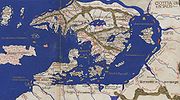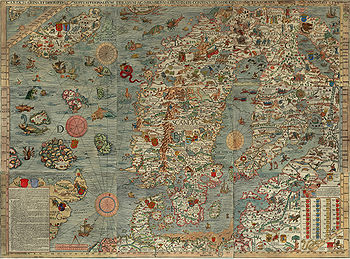
Scandia
Encyclopedia
Scandia was a name used for various uncharted islands in Northern Europe
by the first Greek and Roman geographers. The name originated in Greek sources, where it had been used for a long time for different islands in the Mediterranean region. In the Iliad
the name denotes an ancient city in Kythira
, Greece
.

 The first attested written source using the name for a Northern European island is the work of Roman Pliny the Elder
The first attested written source using the name for a Northern European island is the work of Roman Pliny the Elder
, Naturalis Historia
of c. AD 77. Pliny described "Scandia" as an island located north of Britannia
. This island does not appear to be the same as the island Pliny calls "Scatinavia", located near Cimbri
. In Claudius Ptolemy's Geographia, written in the 2nd century AD, Scandia is described as the most easterly of the Scandiae islands, a group of islands located east of the Cimbrian peninsula. This is the region where Pliny had located "Scatinavia". The name "Scandia" was therefore after Ptolemy generally associated with the southern part of Scandinavian peninsula
by the early Roman geographers, who thought of Scandinavia as an island.
When Scandinavian scholars became familiar with the Roman records in the Middle Ages
, Scandiae was used as an alternative Latin name for Terra Scania. The early 13th century Latin paraphrase of the Scanian Law
is called Lex Scandiae provincialis.
In the 16th century, Olaus Magnus
, a Swedish cartographer who was familiar with Pliny's writings, created a map where he placed the name "Scandia" in the middle of today's Sweden
. In Olaus Magnus' map, the name denotes an area including "Svecia" (Svealand
), "Gothia
" and "Norvegia" (Norway
), where he places various tribes described by the ancient geographers.
Although mainly a historical name, Scandia is still occasionally used today as a Latin name for Scandinavia
. The Scandinavian Bishops Conference
, an Episcopal Conference
organized by the Roman Catholic Church
since 1923, is called Conferentia Episcopalis Scandiae.
Northern Europe
Northern Europe is the northern part or region of Europe. Northern Europe typically refers to the seven countries in the northern part of the European subcontinent which includes Denmark, Estonia, Latvia, Lithuania, Norway, Finland and Sweden...
by the first Greek and Roman geographers. The name originated in Greek sources, where it had been used for a long time for different islands in the Mediterranean region. In the Iliad
Iliad
The Iliad is an epic poem in dactylic hexameters, traditionally attributed to Homer. Set during the Trojan War, the ten-year siege of the city of Troy by a coalition of Greek states, it tells of the battles and events during the weeks of a quarrel between King Agamemnon and the warrior Achilles...
the name denotes an ancient city in Kythira
Kythira
Cythera is an island in Greece, once part of the Ionian Islands. It lies opposite the south-eastern tip of the Peloponnese peninsula. It is administratively part of the Islands regional unit, which is part of the Attica region , Greece.For many centuries, while naval travel was the only means...
, Greece
Greece
Greece , officially the Hellenic Republic , and historically Hellas or the Republic of Greece in English, is a country in southeastern Europe....
.


Pliny the Elder
Gaius Plinius Secundus , better known as Pliny the Elder, was a Roman author, naturalist, and natural philosopher, as well as naval and army commander of the early Roman Empire, and personal friend of the emperor Vespasian...
, Naturalis Historia
Naturalis Historia
The Natural History is an encyclopedia published circa AD 77–79 by Pliny the Elder. It is one of the largest single works to have survived from the Roman Empire to the modern day and purports to cover the entire field of ancient knowledge, based on the best authorities available to Pliny...
of c. AD 77. Pliny described "Scandia" as an island located north of Britannia
Britannia
Britannia is an ancient term for Great Britain, and also a female personification of the island. The name is Latin, and derives from the Greek form Prettanike or Brettaniai, which originally designated a collection of islands with individual names, including Albion or Great Britain. However, by the...
. This island does not appear to be the same as the island Pliny calls "Scatinavia", located near Cimbri
Cimbri
The Cimbri were a tribe from Northern Europe, who, together with the Teutones and the Ambrones threatened the Roman Republic in the late 2nd century BC. The Cimbri were probably Germanic, though some believe them to be of Celtic origin...
. In Claudius Ptolemy's Geographia, written in the 2nd century AD, Scandia is described as the most easterly of the Scandiae islands, a group of islands located east of the Cimbrian peninsula. This is the region where Pliny had located "Scatinavia". The name "Scandia" was therefore after Ptolemy generally associated with the southern part of Scandinavian peninsula
Scandinavian Peninsula
The Scandinavian Peninsula is a peninsula in Northern Europe, which today covers Norway, Sweden, and most of northern Finland. Prior to the 17th and 18th centuries, large parts of the southern peninsula—including the core region of Scania from which the peninsula takes its name—were part of...
by the early Roman geographers, who thought of Scandinavia as an island.
When Scandinavian scholars became familiar with the Roman records in the Middle Ages
Middle Ages
The Middle Ages is a periodization of European history from the 5th century to the 15th century. The Middle Ages follows the fall of the Western Roman Empire in 476 and precedes the Early Modern Era. It is the middle period of a three-period division of Western history: Classic, Medieval and Modern...
, Scandiae was used as an alternative Latin name for Terra Scania. The early 13th century Latin paraphrase of the Scanian Law
Scanian Law
Scanian law is the oldest Danish provincial law and one of the first Nordic provincial laws to be written down. It was used in the geographic region of Danish Skåneland, which at the time included Scania, Halland, Blekinge and the island of Bornholm. It was also used for a short period on the...
is called Lex Scandiae provincialis.
In the 16th century, Olaus Magnus
Olaus Magnus
Olaus Magnus was a Swedish ecclesiastic and writer, who did pioneering work for the interest of Nordic people. He was reported as born in October 1490 in Östergötland, and died on August 1, 1557. Magnus, Latin for the Swedish Stor “great”, is a Latin family name taken personally, and not a...
, a Swedish cartographer who was familiar with Pliny's writings, created a map where he placed the name "Scandia" in the middle of today's Sweden
Sweden
Sweden , officially the Kingdom of Sweden , is a Nordic country on the Scandinavian Peninsula in Northern Europe. Sweden borders with Norway and Finland and is connected to Denmark by a bridge-tunnel across the Öresund....
. In Olaus Magnus' map, the name denotes an area including "Svecia" (Svealand
Svealand
Svealand , Swealand or Sweden proper is the historical core region of Sweden. It is located in south central Sweden and is one of three lands of Sweden, bounded to the north by Norrland and to the south by Götaland. Deep forests, Tiveden, Tylöskog, Kolmården, separated Svealand from Götaland...
), "Gothia
Gothia
Gothia is a name given to various places where the Goths lived during their migrations:* Götaland, the traditional original homeland of the Goths.* Dacia was referred to as Gothia during the fourth century, when it was settled by Goths....
" and "Norvegia" (Norway
Norway
Norway , officially the Kingdom of Norway, is a Nordic unitary constitutional monarchy whose territory comprises the western portion of the Scandinavian Peninsula, Jan Mayen, and the Arctic archipelago of Svalbard and Bouvet Island. Norway has a total area of and a population of about 4.9 million...
), where he places various tribes described by the ancient geographers.
Although mainly a historical name, Scandia is still occasionally used today as a Latin name for Scandinavia
Scandinavia
Scandinavia is a cultural, historical and ethno-linguistic region in northern Europe that includes the three kingdoms of Denmark, Norway and Sweden, characterized by their common ethno-cultural heritage and language. Modern Norway and Sweden proper are situated on the Scandinavian Peninsula,...
. The Scandinavian Bishops Conference
Scandinavian Bishops Conference
The Scandinavian Bishops Conference is an episcopal conference of Roman Catholic bishops covering the Nordic countries of Sweden, Norway, Finland, Denmark and Iceland. At present, it has 12 members who represent all seven of the Catholic dioceses in the Nordic countries...
, an Episcopal Conference
Episcopal Conference
In the Roman Catholic Church, an Episcopal Conference, Conference of Bishops, or National Conference of Bishops is an official assembly of all the bishops of a given territory...
organized by the Roman Catholic Church
Roman Catholic Church
The Catholic Church, also known as the Roman Catholic Church, is the world's largest Christian church, with over a billion members. Led by the Pope, it defines its mission as spreading the gospel of Jesus Christ, administering the sacraments and exercising charity...
since 1923, is called Conferentia Episcopalis Scandiae.

